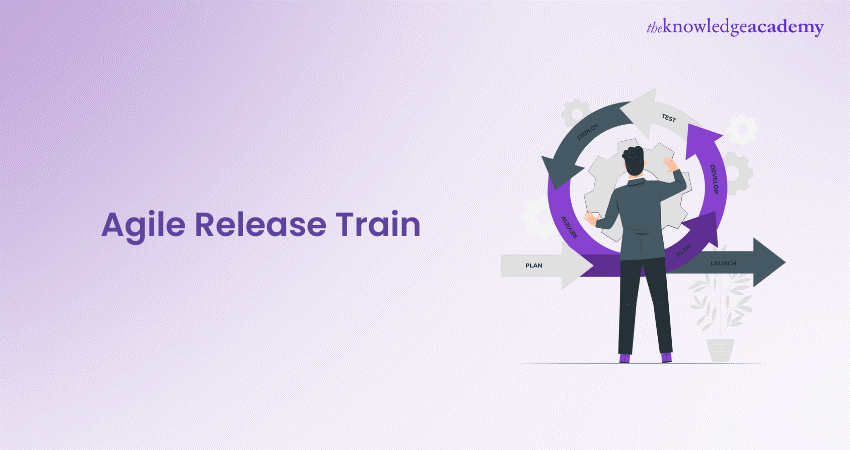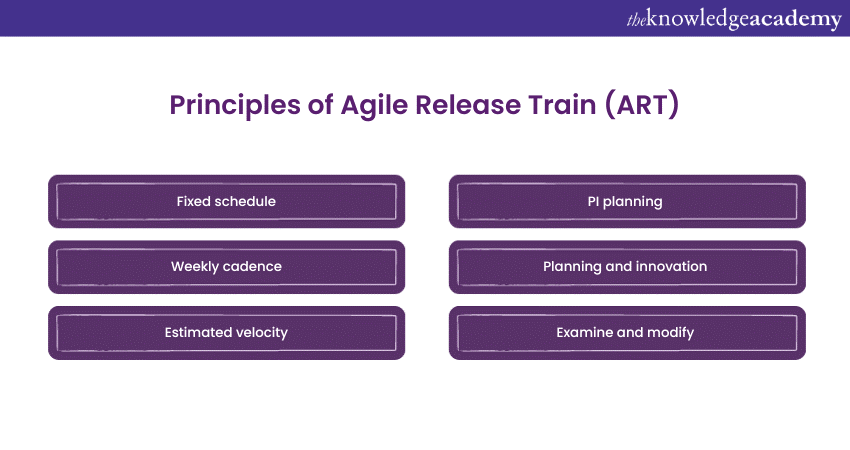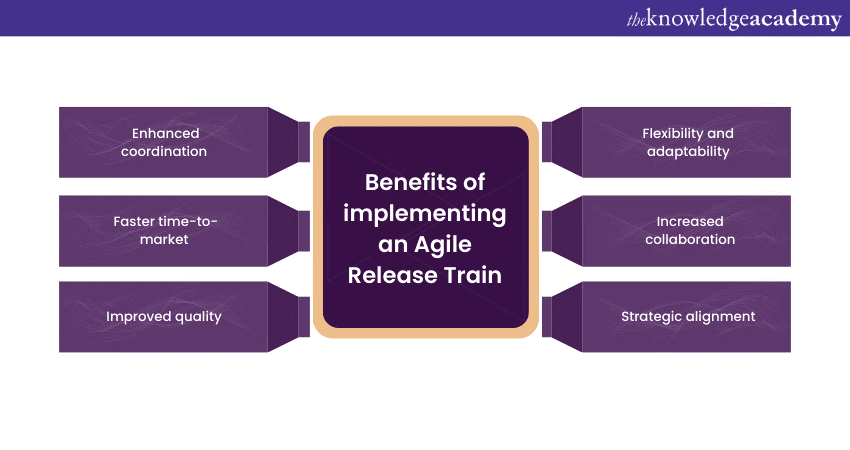We may not have the course you’re looking for. If you enquire or give us a call on 01344203999 and speak to our training experts, we may still be able to help with your training requirements.
Training Outcomes Within Your Budget!
We ensure quality, budget-alignment, and timely delivery by our expert instructors.

In the fast-paced world of software development, Agile methodologies have become the standard for managing projects. But what happens when you need to scale up these Agile practices for larger organisations and more complex projects? This is where the concept of the Agile Release Train (ART) comes into play.
An Agile Release Train (ART) is a crucial concept in the Scaled Agile Framework, involving a structured, organised, and efficient team of Agile teams. In this blog, we'll break down the key elements of an ART, its roles, its characteristics, and the benefits it brings to the table.
Table of contents
1) What is an Agile Release Train?
2) Principles of Agile Release Train (ART)
3) Agile Release Train (ART) responsibilities
4) Roles of Agile Release Train
5) Characteristics of Agile Release Train (ART)
6) Benefits of implementing an Agile Release Train
7) Conclusion
What is an Agile Release Train?
An Agile Release Train (ART) is a concept commonly used in the Scaled Agile Framework (SAFe), which is a framework for scaling Agile principles and methods to large organisations. An ART is a team of Agile teams working collaboratively to deliver value in a scaled Agile environment. It is a way to organise and align multiple Agile teams working on related products or solutions to ensure they are all moving in the same direction and delivering value in a coordinated and efficient manner.
Principles of Agile Release Train (ART)

The principles you've listed are not typically recognised as the official guiding principles of an Agile Release Train (ART) in the context of the Scaled Agile Framework (SAFe). However, I can provide explanations for each of these principles, as you've mentioned:
1) Fixed schedule: This principle suggests that an ART adheres to a set, predetermined schedule for planning, execution, and delivery. The Program Increment (PI) in SAFe is an example of a fixed schedule, typically lasting 8-12 weeks. This ensures that teams work within known timeframes, making it easier to plan and align their efforts.
2) Weekly cadence: A weekly cadence implies that there are recurring events or meetings happening on a weekly basis within the ART. In SAFe, this could refer to various Agile ceremonies like sprint planning, daily stand-ups, and sprint reviews, which often occur weekly in Agile teams. It helps in maintaining a regular rhythm of work and collaboration.
3) Estimated velocity: This principle involves estimating the team's velocity or the amount of work a team can complete in a fixed period, often measured in story points or other relative units. Velocity helps forecast how much work can be accomplished during a program increment or other timeframes. It's a crucial aspect of Agile planning and execution.
4) PI planning: PI (Program Increment) Planning is a core event in SAFe where teams, stakeholders, and leaders come together to plan and prioritise the work for the upcoming Program Increment. This event ensures alignment, sets objectives, and creates a plan for the entire ART to work towards during the PI.
5) Planning and innovation: This principle implies that the ART should not only focus on execution but also allocate time for planning and innovation. During a PI, teams should not only deliver known features but also allocate some capacity for exploration, experimentation, and innovation to address emerging opportunities and challenges.
6) Examine and modify: This principle encourages regular inspection and adaptation, which is a fundamental concept in Agile. Teams and the ART should periodically review their work, identify areas for improvement, and be willing to modify their processes, practices, and plans to better meet their goals and respond to changing circumstances.
Unlock your potential with our comprehensive Agile interview question guide. Start learning today!
Agile Release Train (ART) responsibilities
An Agile Release Train (ART) in the context of the Scaled Agile Framework (SAFe) has several key responsibilities to ensure the successful delivery of value in a large-scale Agile environment. These responsibilities include:
1) Delivering value: The primary responsibility of an ART is to deliver value to customers and stakeholders. This involves the regular and predictable delivery of working, tested, and potentially shippable solutions. The ART works collaboratively to achieve this goal.
2) PI planning: The ART participates in Program Increment (PI) planning, a critical event that occurs at the start of each PI. During PI planning, the ART aligns priorities, identifies features and stories to be delivered, and establishes a plan for the upcoming PI. This event is crucial for coordination and alignment across all teams.
3) Inspect and Adapt (I&A): The ART conducts regular Inspect and Adapt (I&A) workshops at the end of each Program Increment. During I&A, the ART reviews the PI's accomplishments, identifies areas for improvement, and adapts their plans and practices accordingly. This continuous improvement process is vital for optimising performance.
4) Alignment: Ensuring alignment with the organisation's strategic objectives and portfolio priorities is a key responsibility of the ART. This involves regularly reviewing the organisation's strategy and making sure that the work being performed on the ART is aligned with these strategic goals.
5) Dependency management: Managing dependencies among teams and between features is a critical responsibility of the ART. This includes identifying and addressing cross-team dependencies, ensuring that dependencies do not impede progress, and taking steps to resolve or minimise them.
6) Backlog refinement: The ART actively participates in backlog refinement sessions to ensure that the backlog contains well-defined, prioritised features and stories. This helps the teams plan their work effectively and maintain a constant flow of work.
7) Collaboration: Promoting collaboration and a sense of shared purpose among the Agile teams within the ART is crucial. Teams should work together closely, share knowledge, and help each other to ensure the success of the entire ART.
8) Problem-solving: Teams on the ART should be encouraged and empowered to address issues and solve problems as they arise. This includes resolving impediments, improving processes, and finding innovative solutions to challenges.
9) Customer focus: Maintaining a strong customer focus is essential. The ART should continuously engage with customers and stakeholders to understand their needs and gather feedback to guide the development of solutions.
10) Economic prioritisation: The ART should prioritise work based on economic considerations. This means that they should focus on high-value items, considering both the cost and the potential benefits of delivering specific features or capabilities.
11) Transparency and reporting: The ART should maintain transparency in all its activities. This includes providing visibility into the progress, impediments, and performance metrics to stakeholders and leadership.
Unlock the power of Agile product management with our SAFe® Agile Product Management Training!
Roles of Agile Release Train
The Agile Release Train (ART) in the Scaled Agile Framework (SAFe) involves several key roles that are responsible for various aspects of planning, coordination, and execution within the ART. These roles help ensure the successful delivery of value in a large-scale Agile environment. Here are the key roles within an Agile Release Train:
1) Release Train Engineer (RTE): The Release Train Engineer plays a crucial role in facilitating the planning and execution of the Program Increment (PI). They serve as the chief Scrum Master for the ART, facilitating PI planning, coordinating with other ARTs, and removing impediments to ensure that the teams can deliver value effectively.
2) Product Owner: Each Agile team on the ART has its own Product Owner, who is responsible for managing the team's backlog, prioritising work items, and ensuring the team delivers value that aligns with the program's goals. They work closely with the Product Management team and stakeholders to define and refine features and user stories.
3) Scrum Master: Each Agile team also has its own Scrum Master, responsible for facilitating the team's Agile practices, removing impediments, and fostering a high-performing, self-organised team.
4) Product Management: The Product Management team collaborates with Product Owners to define and prioritise the program's backlog. They are responsible for ensuring that the features and capabilities developed align with the organisation's strategic goals and customer needs.
5) System Architect: The System Architect or Solution Architect is responsible for the technical leadership and guidance needed to ensure that the solutions being developed within the ART are coherent and aligned with architectural and design principles.
6) Business Owners: Business Owners are typically senior stakeholders who provide input and guidance to the ART based on business objectives and customer needs. They help set priorities and are accountable for the overall success of the ART.
7) Scrum Masters and Product Owners for Shared Services: If the ART includes shared services teams, these roles may exist to serve these specialised functions, much like the Scrum Masters and Product Owners for the individual Agile teams.
8) DevOps and Release on Demand: These roles are responsible for coordinating and facilitating the release of solutions into production. They ensure that the Continuous Delivery Pipeline is optimised and that solutions are ready for release when needed.
9) Business Owners for Value Streams: In larger organisations with multiple value streams or ARTs, Business Owners for Value Streams help coordinate value delivery and ensure alignment across different parts of the organisation.
Unlock your potential and drive your career forward with our SAFe Agile Certification!
Characteristics of Agile Release Train (ART)
An Agile Release Train (ART) in the context of the Scaled Agile Framework (SAFe) exhibits several key characteristics that distinguish it from traditional project or program management. These characteristics are essential for enabling large-scale Agile development and ensuring the coordinated delivery of value. Here are the main characteristics of an Agile Release Train (ART):
1) Cross-functional teams: ARTs consist of multiple Agile teams, each with a diverse set of skills necessary to develop, test, and deliver a complete solution or product. These teams are self-organising and cross-functional, reducing the need for handoffs and dependencies.
2) Program Increment (PI): ARTs operate within fixed, time-boxed Program Increments, typically lasting 8-12 weeks. This regular cadence provides a predictable rhythm for planning, execution, and inspecting the work.
3) PI Planning: PI planning is a significant event in the ART. It's a collaborative, face-to-face meeting where all teams come together to plan and prioritise the work for the upcoming Program Increment. This ceremony ensures alignment and commitment to common objectives.
4) Value Stream or Solution-Centric: ARTs are organised around a specific value stream or a solution. This means that teams within the ART work together to deliver features, capabilities, and user stories that contribute to a coherent solution that addresses customer needs.
5) Inspect and Adapt (I&A): At the end of each Program Increment, ARTs conduct an Inspect and Adapt (I&A) workshop. During this event, teams review their work, identify areas for improvement, and adapt their plans and practices for the next PI. This continuous improvement process is crucial for optimising performance.
6) Alignment with Strategic Objectives: ARTs align with the organisation's strategic objectives and portfolio priorities. This ensures that the work being done on the ART directly supports the organisation's overarching goals.
7) Release on Demand: ARTs focus on the ability to release value to customers on demand. This involves having a well-orchestrated and efficient Continuous Delivery Pipeline, ensuring that the solution is always in a release-ready state.
8) Collaboration and Transparency: Collaboration and transparency are essential characteristics of ARTs. Teams work closely together, communicate openly, and share information to avoid misunderstandings and encourage shared goals.
Gain AgilePM® expertise and drive project success. Join our Agile Project Management Practitioner (AgilePM®) Course today!
Benefits of implementing an Agile Release Train

Implementing an Agile Release Train (ART) can offer a wide range of benefits to organisations, particularly those looking to scale Agile practices for large and complex projects. Here are some of the significant advantages of incorporating an ART into your development process:
1) Enhanced coordination: ARTs bring multiple Agile teams together, fostering better communication and alignment. This coordination reduces duplication of efforts, minimises bottlenecks, and ensures that all teams are working toward the same goals.
2) Faster time-to-market: ARTs emphasise regular Program Increments (PIs) and a focus on value delivery. This results in faster development cycles and quicker time-to-market for new features and solutions.
3) Improved quality: By encouraging the delivery of working, tested, and potentially shippable increments of a solution within each PI, ARTs promote higher quality products with fewer defects. The Inspect and Adapt (I&A) process further ensures continuous improvement in quality.
4) Flexibility and adaptability: Agile Release Trains are designed to be responsive to change. The regular PI cadence allows for adjustments based on feedback, evolving requirements, and changing market conditions.
5) Increased collaboration: Collaboration among teams, Product Owners, Scrum Masters, and other stakeholders is a cornerstone of ARTs. This collaborative approach leads to better decision-making, shared knowledge, and a strong sense of shared purpose.
6) Strategic alignment: ARTs align their work with the strategic objectives and priorities of the organisation. This ensures that the development efforts are always in sync with the company's larger vision and goals.
Conclusion
Hope we could answer all your questions on ART. The Agile Release Train (ART) is a powerful concept within the Scaled Agile Framework (SAFe) that provides organisations with a structured and effective way to scale Agile practices for large and complex projects.
Supercharge your software engineering skills with SAFe® Agile Software Engineering Training. Elevate your career now!
Frequently Asked Questions
Upcoming Project Management Resources Batches & Dates
Date
 Agile Software Testing
Agile Software Testing
Thu 6th Feb 2025
Thu 24th Apr 2025
Thu 3rd Jul 2025
Thu 23rd Oct 2025







 Top Rated Course
Top Rated Course



 If you wish to make any changes to your course, please
If you wish to make any changes to your course, please


